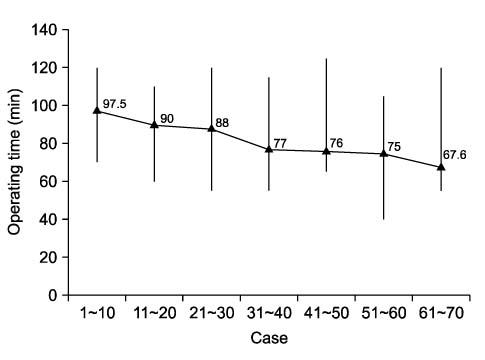J Korean Surg Soc.
2011 Feb;80(2):119-124. 10.4174/jkss.2011.80.2.119.
The Learning Curve for Single-Port Laparoscopic Cholecystectomy by Experienced Laparoscopic Surgeon
- Affiliations
-
- 1Department of Surgery, Dong-A University College of Medicine, Busan, Korea. gsryh@dau.ac.kr
- 2Department of Pathology, Dong-A University College of Medicine, Busan, Korea.
- KMID: 2117119
- DOI: http://doi.org/10.4174/jkss.2011.80.2.119
Abstract
- PURPOSE
Single-port laparoscopic surgery is a rapidly advancing technique in laparoscopic surgery. However, there is currently limited evidence on the learning curve for this procedure. The aim of this study was to estimate the number of single port laparoscopic cholecystectomies required until improvement in the performance of the technique ceases.
METHODS
This is a descriptive, single-center study using routinely collected clinical data from 70 patients who underwent single port laparoscopic cholecystectomy between May 2009 and June 2010 at Dong-A University Medical Center in Busan, Korea. The review includes the mean operating time, conversion cases, intra-operative GB perforation, post-operative wound infection and mean hospital stay.
RESULTS
The mean operating time of the first 30 cases (the learning period) was 91.83 minutes. After 30 operations (the experience period), it plateaued to an average of 75.25 minutes, which remained steady in the next 40 operations - a reduction of more than 16%. Reduction in the operating time was significant (P<0.001) between the learning period and the experience period. Other factors including additional ports, intraoperative gall bladder perforation, mean hospital stay, post-operative wound infection were not significantly different between the two periods.
CONCLUSION
We suggest that the learning curve for single port laparoscopic cholecystectomy should be around thirty cases for a surgeon with prior conventional laparoscopic cholecystectomy experience and for self-taught single port technique.
Keyword
MeSH Terms
Figure
Reference
-
1. Peters JH, Ellison EC, Innes JT, Liss JL, Nichols KE, Lomano JM, et al. Safety and efficacy of laparoscopic cholecystectomy. A prospective analysis of 100 initial patients. Ann Surg. 1991. 213:3–12.2. Yi NJ, Han HS, Kim YW, Min SK, Choi YM. The safety of a laparoscopic cholecystectomy in acute cholecystitis in high-risk patients older than sixty with stratification based on ASA score. Minim Invasive Ther Allied Technol. 2006. 15:159–164.3. Leung KF, Lee KW, Cheung TY, Leung LC, Lau KW. Laparoscopic cholecystectomy: two-port technique. Endoscopy. 1996. 28:505–507.4. Navarra G, Pozza E, Occhionorelli S, Carcoforo P, Donini I. One-wound laparoscopic cholecystectomy. Br J Surg. 1997. 84:695.5. Ramachandran CS, Arora V. Two-port laparoscopic cholecystectomy: an innovative new method for gallbladder removal. J Laparoendosc Adv Surg Tech A. 1998. 8:303–308.6. Avgerinos C, Kelgiorgi D, Touloumis Z, Baltatzi L, Dervenis C. One thousand laparoscopic cholecystectomies in a single surgical unit using the "critical view of safety" technique. J Gastrointest Surg. 2009. 13:498–503.7. Edwards C, Bradshaw A, Ahearne P, Dematos P, Humble T, Johnson R, et al. Single-incision laparoscopic cholecystectomy is feasible: initial experience with 80 cases. Surg Endosc. 2010. 24:2241–2247.8. Erbella J Jr, Bunch GM. Single-incision laparoscopic cholecystectomy: the first 100 outpatients. Surg Endosc. 2010. 24:1958–1961.9. Hong TH, Kim HL, Lee YS, Kim JJ, Lee KH, You YK, et al. Transumbilical single-port laparoscopic appendectomy (TUSPLA): scarless intracorporeal appendectomy. J Laparoendosc Adv Surg Tech A. 2009. 19:75–78.10. Hong TH, You YK, Lee KH. Transumbilical single-port laparoscopic cholecystectomy: scarless cholecystectomy. Surg Endosc. 2009. 23:1393–1397.11. Voitk AJ, Tsao SG, Ignatius S. The tail of the learning curve for laparoscopic cholecystectomy. Am J Surg. 2001. 182:250–253.12. Teplitz CJ. The Learning Curve Deskbook: A Reference Guide to Theory, Calculations and Applications. 1991. New York: Quorum Books.13. Mishne JM. The Learning Curve: Elevating Children's Academic and Social Competence. 1996. Dunmore, Penn: Jason Aronson.14. Birren JE, Schaie KW. Handbook of the Psychology of Aging. 1990. San Diego: Academic Press.15. Hunter JG, Sackier JM, Berci G. Training in laparoscopic cholecystectomy Quantifying the learning curve. Surg Endosc. 1994. 8:28–31.16. Solomon D, Bell RL, Duffy AJ, Roberts KE. Single-port cholecystectomy: small scar, short learning curve. Surg Endosc. 2010. 24:2954–2957.17. Kravetz AJ, Iddings D, Basson MD, Kia MA. The learning curve with single-port cholecystectomy. JSLS. 2009. 13:332–336.18. Romanelli JR, Earle DB. Single-port laparoscopic surgery: an overview. Surg Endosc. 2009. 23:1419–1427.19. Podolsky ER, Rottman SJ, Poblete H, King SA, Curcillo PG. Single port access (SPA) cholecystectomy: a completely transumbilical approach. J Laparoendosc Adv Surg Tech A. 2009. 19:219–222.20. Hasan A, Pozzi M, Hamilton JR. New surgical procedures: can we minimise the learning curve? BMJ. 2000. 320:171–173.21. Tekkis PP, Senagore AJ, Delaney CP, Fazio VW. Evaluation of the learning curve in laparoscopic colorectal surgery: comparison of right-sided and left-sided resections. Ann Surg. 2005. 242:83–91.22. Marusch F, Gastinger I, Schneider C, Scheidbach H, Konradt J, Bruch HP, et al. Experience as a factor influencing the indications for laparoscopic colorectal surgery and the results. Surg Endosc. 2001. 15:116–120.
- Full Text Links
- Actions
-
Cited
- CITED
-
- Close
- Share
- Similar articles
-
- Transumbilical Laparoscopic Cholecystectomy with Additional Port: A Single Surgeon's Experience with 291 Cases
- Single Port Laparoscopic Cholecystectomy in a Patient with Situs Inversus Totalis: A Case Report
- Comparison of Single-Incision Robotic Cholecystectomy, Single-Incision Laparoscopic Cholecystectomy and 3-Port Laparoscopic Cholecystectomy -Postoperative Pain, Cosmetic Outcome and Surgeon's Workload
- Single Port Laparoscopic Gastric Wedge Resection: Case Reports
- Transition from Conventional to Reduced-Port Laparoscopic Gastrectomy to Treat Gastric Carcinoma: a Single Surgeon's Experience from a Small-Volume Center


